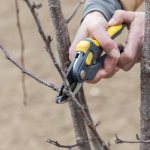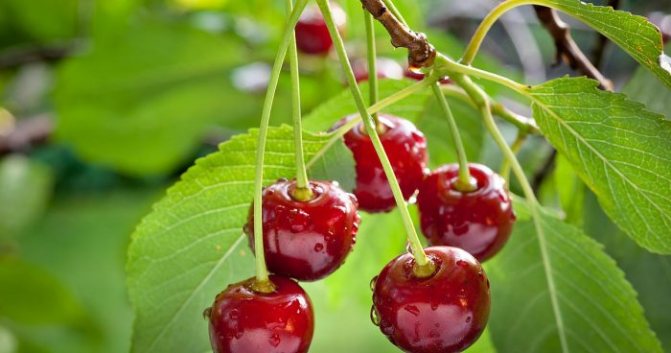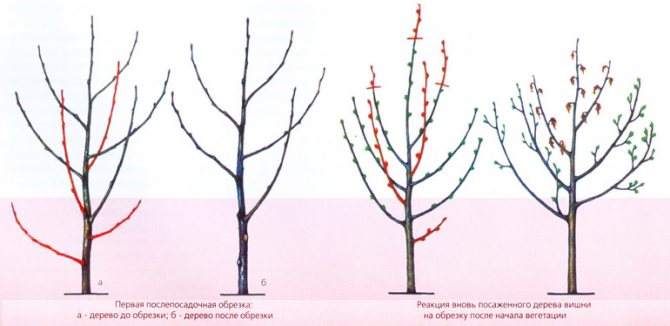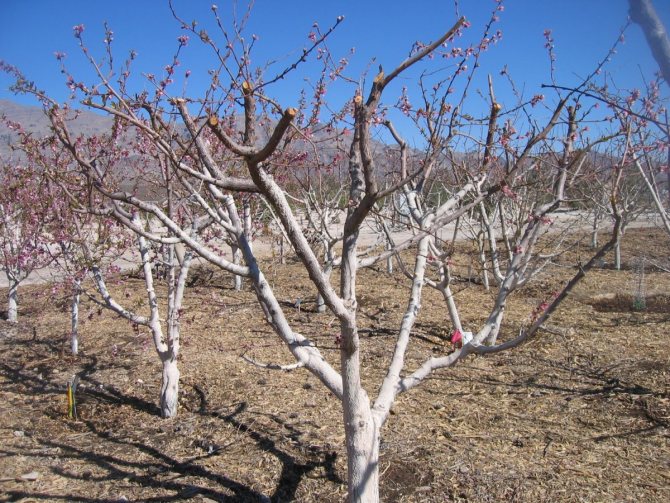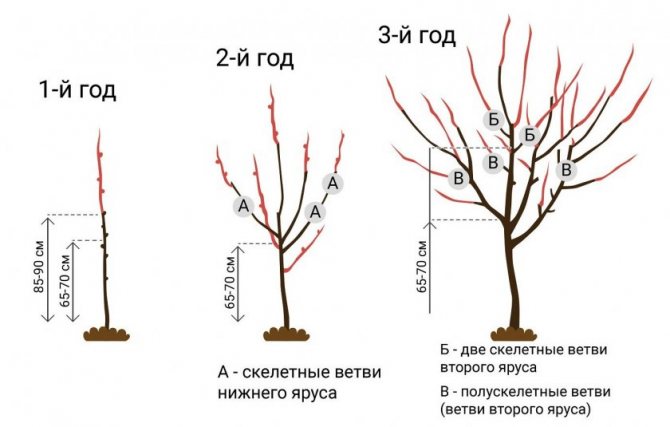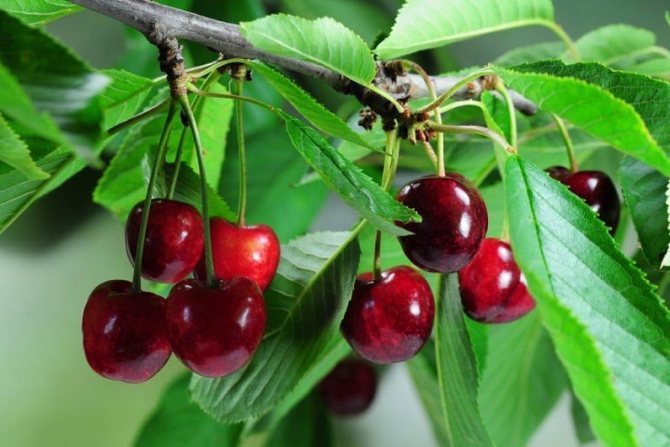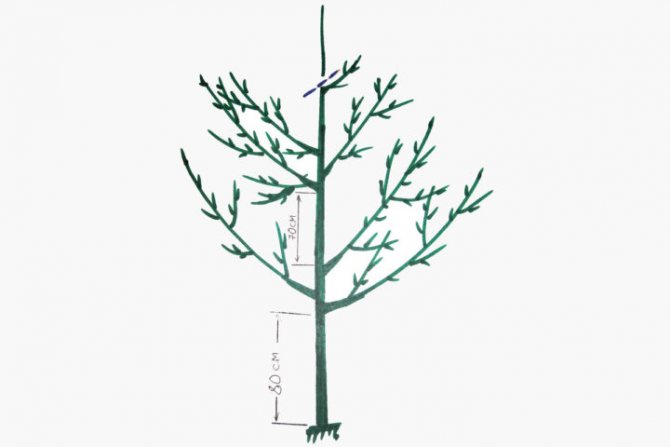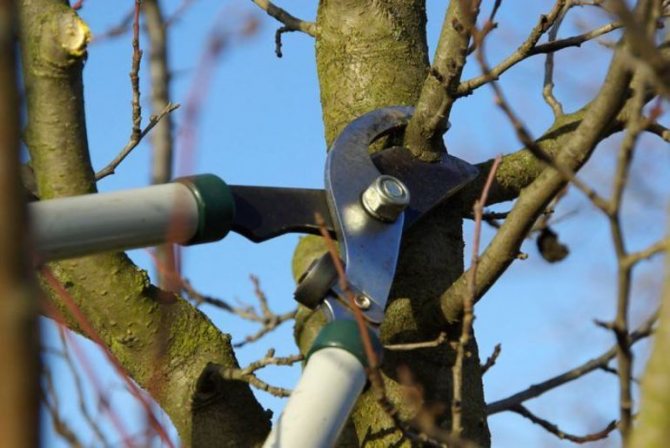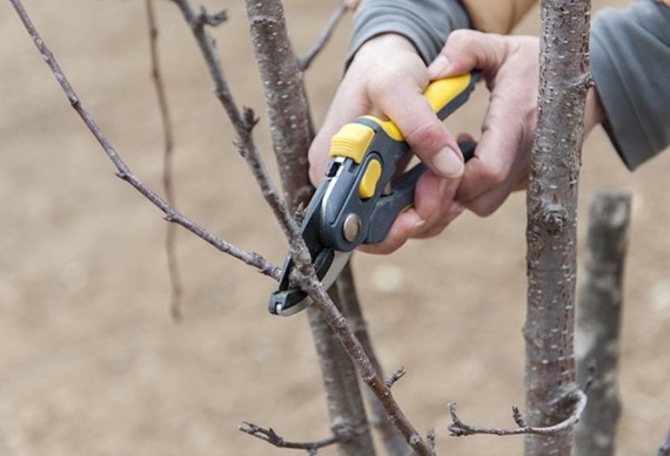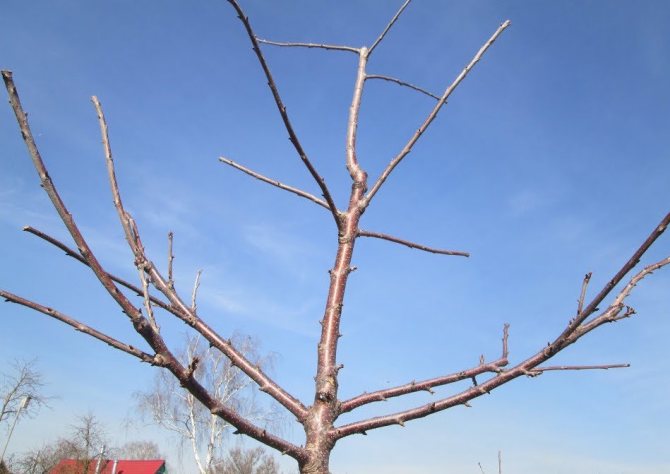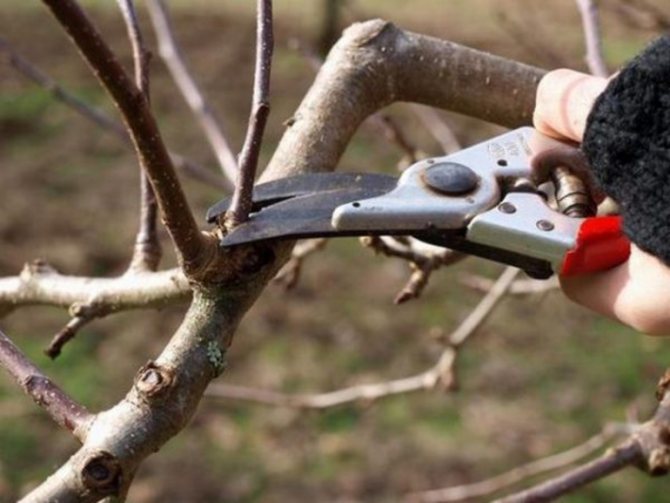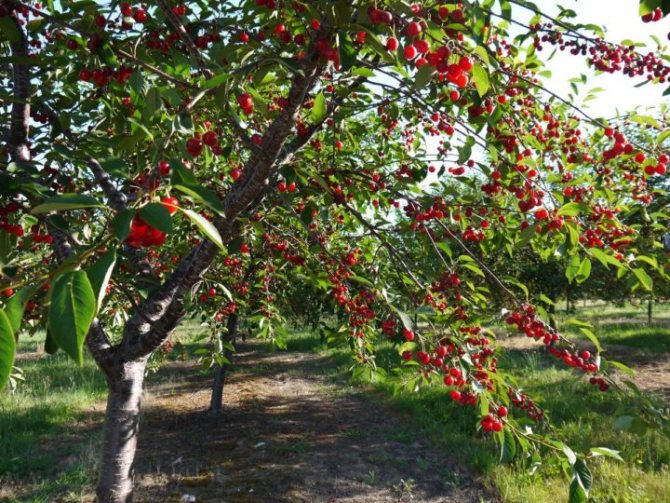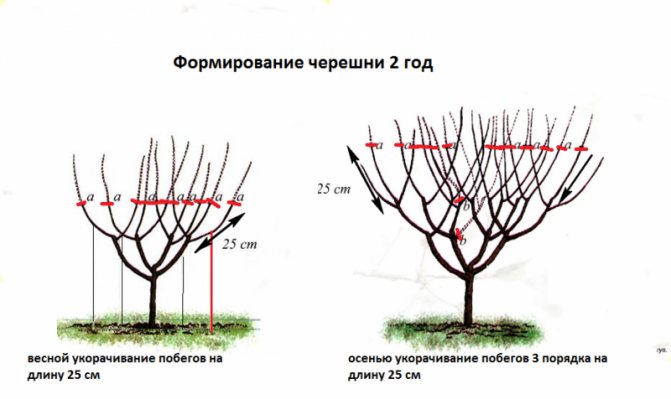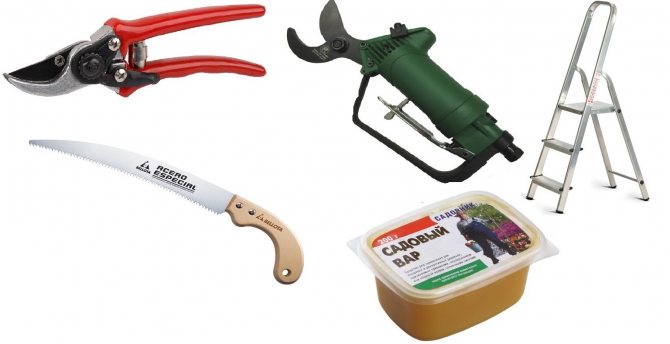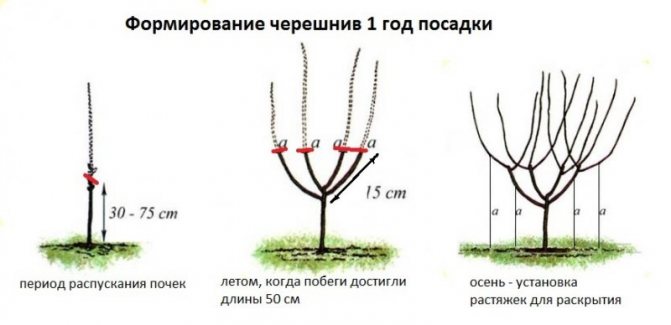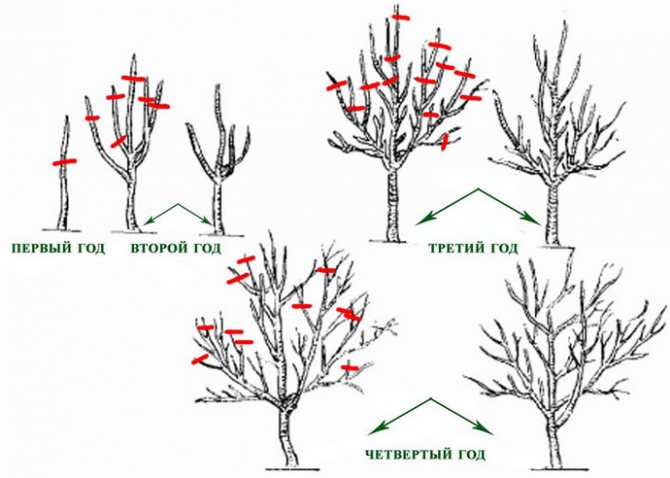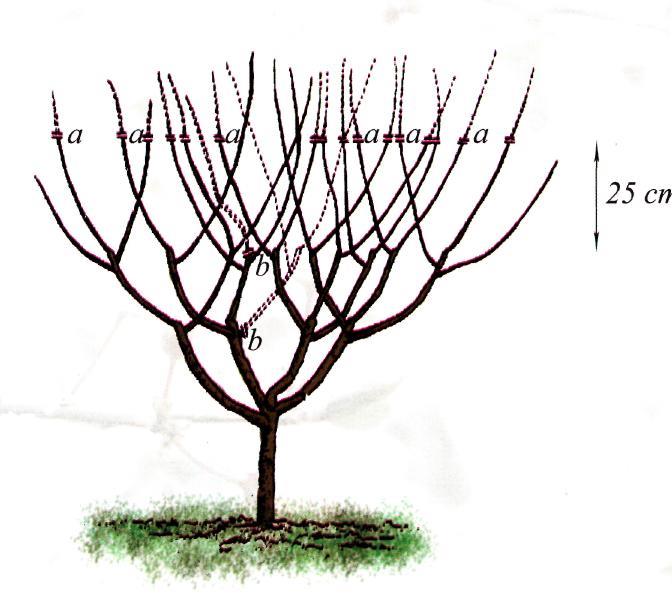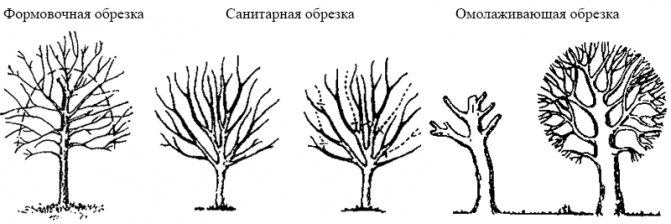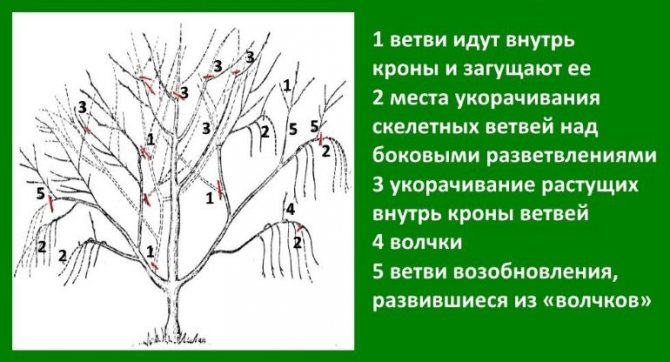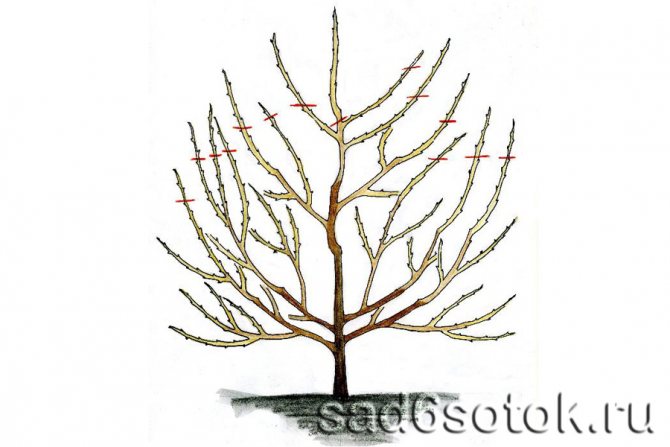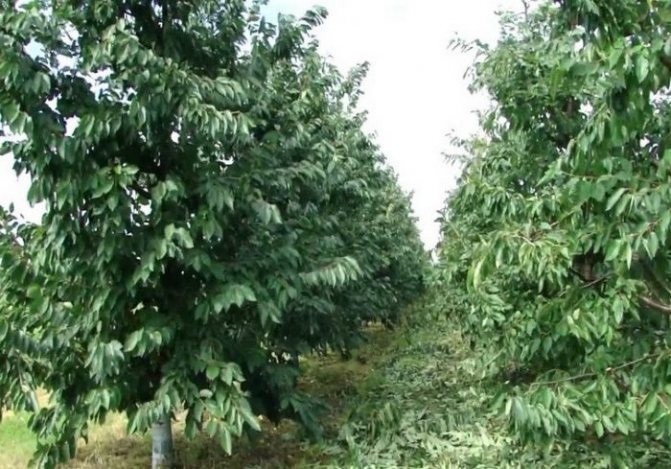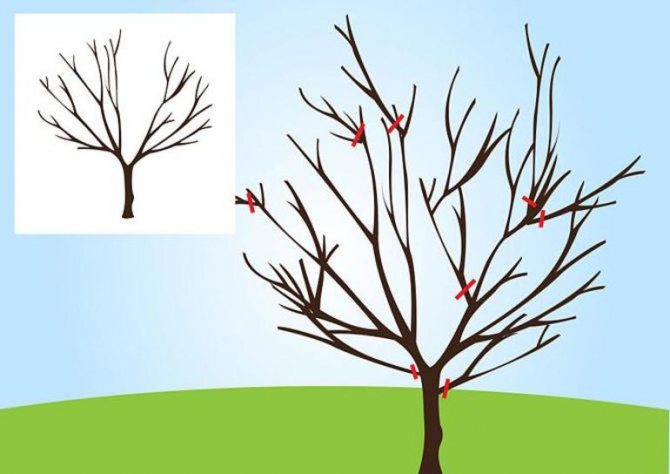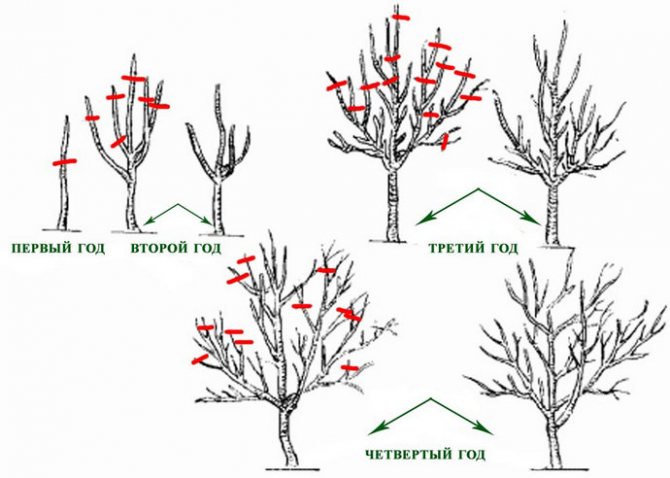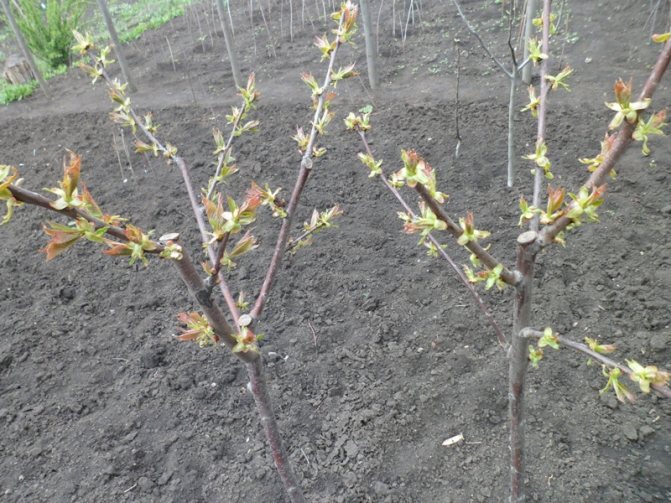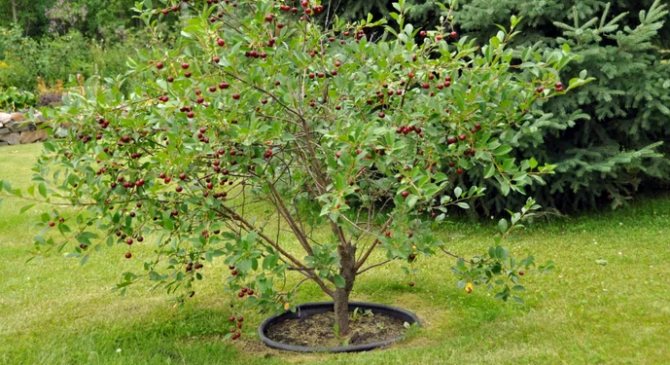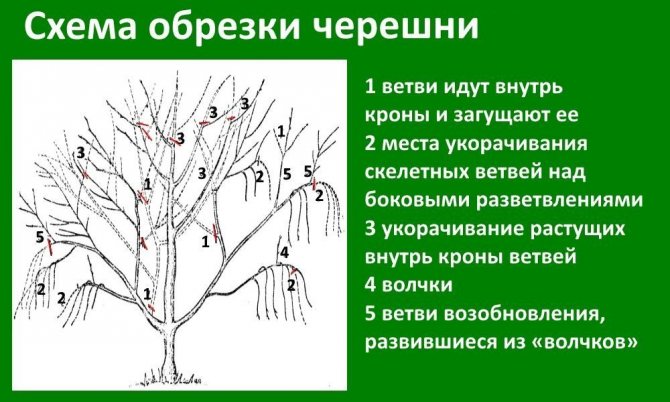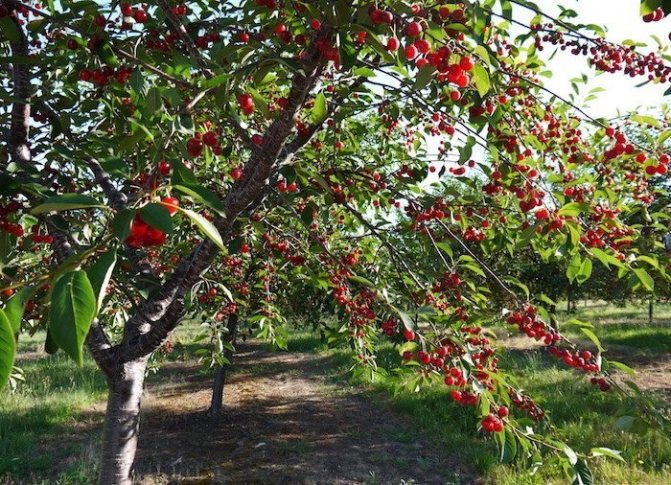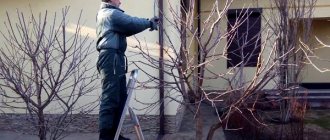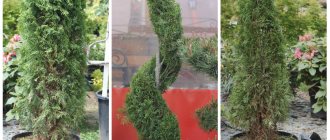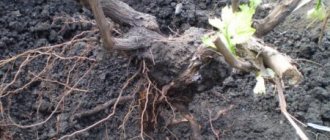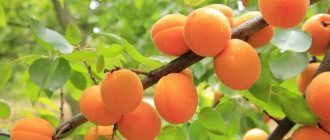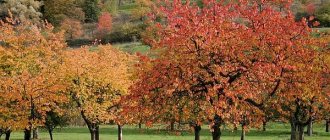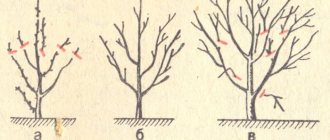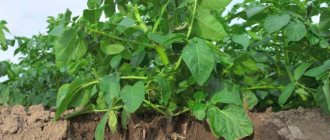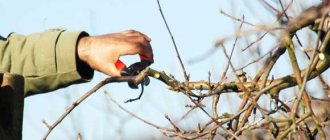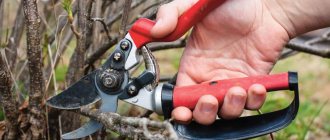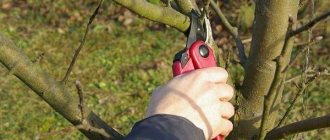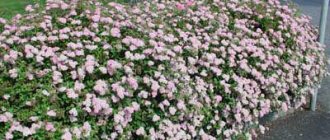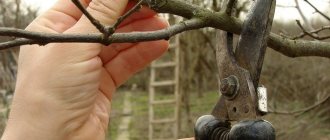When and why is cherry pruning carried out
Sweet cherry is a fast-growing tree, and its growth occurs both upward and in all directions, as a result of which excessive branching strongly thickens the crown. This can lead to breaking off branches, poor ventilation and, as a result, the occurrence of diseases, shrinking fruits and their poor ripening. The strength of the tree is spent on maintaining the leaf mass, and not on the setting and growth of fruits. Therefore, pruning is of great importance for cherries, and it should be carried out annually: if you cut a lot of wood at one time, the tree may not tolerate such stress.
There are different types of pruning that serve one purpose or another:
- shaping (with its help they form the desired crown shape): this pruning is performed during the first 4–5 years of the tree's life, carried out in early spring;
- rejuvenating (its goal is to replace old branches with young ones, prolong fruiting): such pruning is also performed mainly in spring;
- sanitary (when it is performed, dry, broken, diseased branches are removed): this pruning can be carried out both in spring and autumn, and in emergency cases (illness, breakage of branches) even in summer.
The safest and safest way to do any pruning in the spring is before the sap begins to flow. If you carry out the operation without errors, you can prune the cherries in the fall and even in the summer, but not too radically. As with all stone fruits, even the smallest wounds should be covered with garden varnish: if the apple tree often forgives this mistake, then crops such as cherry, sweet cherry or plum can noticeably weaken from gum leakage. It is not necessary to gloss over only the cuts of annual shoots.
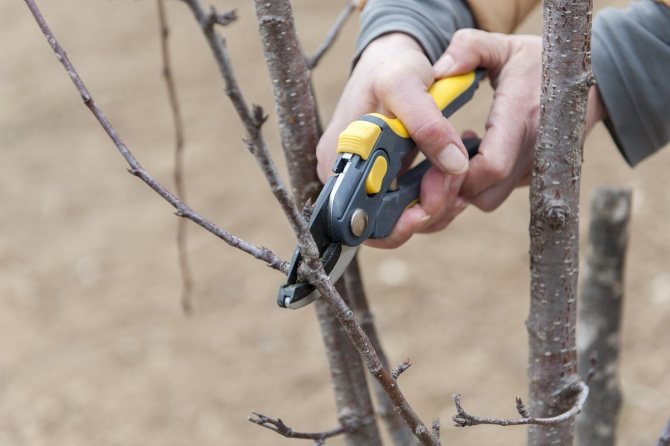
Only sections with a diameter of a few millimeters can be left blank
Dates differ slightly depending on the region: for example, in the middle lane, in particular in the Moscow region, this is usually the very end of March. In the southern regions, the spring pruning time can be in the middle and even, sometimes, the beginning of the month. You should not postpone pruning to April: at this time there is already a danger of harm to the tree due to the beginning of sap flow.
Summer pruning is a two-step process. The first falls on the period between the end of flowering and the beginning of fruit ripening. In most regions and for most cherry varieties, this is the beginning of June. The timing of summer pruning can be adjusted in one direction or another for a week or two. At this time, in addition to sanitary pruning, young shoots are slightly shortened. At the second stage (a week and a half after harvest), the procedure is repeated.
Autumn pruning is carried out immediately after leaf fall. It is of a sanitary and preventive nature and should be completed in the middle lane by the end of September, in the south - by mid-October (although, of course, there is no year after year, it happens that by this time the trees are still green).
What do they do
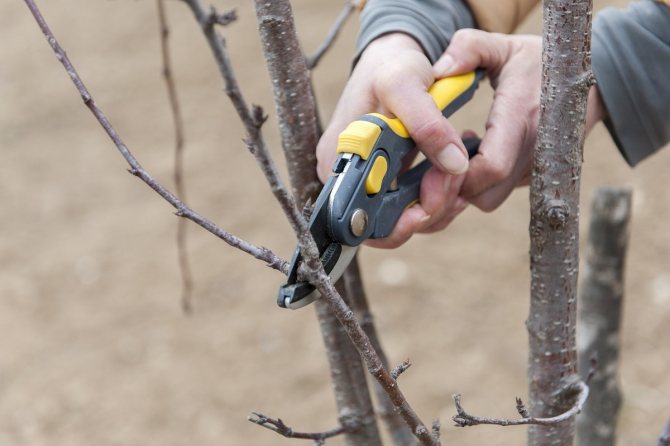

It is necessary to prune cherries in spring, summer, autumn and even sometimes in winter. This manipulation maintains the condition of the tree and guarantees good yields every year. Some gardeners do not subject fruit plants to this procedure, allowing them to grow uncontrollably. But, with this approach, fruiting will be only until the moment of strong thickening of the crown. After that, the quality and volume of the crop suddenly drops.
The reason for the decrease in yield lies in the fact that due to a lack of light inside the thickened crown, the fruit branches die off. These shoots produce few flower buds, and fruit ovaries rarely appear on them. At the same time, the thickened crown is a good environment for the development of diseases. If the cherry crown is formed correctly and pruned on time, this helps the gardener get the following results:
- noticeably increase the yield of the fruit plant;
- improve the quality of the berries removed - juiciness, taste, aroma, sugar content of the pulp;
- increase the frost resistance of the tree;
- increase the lifespan of a specific instance;
- reduce the risks of pest attacks, the development of fungal and other diseases.
How to prune cherries correctly
The technique of correct pruning of cherries is not only difficult, but also controversial: different gardeners have their own point of view on this issue. Therefore, ordinary summer residents only need to know the main points and follow the procedure very carefully.
Pruning young and mature trees
Pruning young trees is mainly formative in nature. Usually in 3-4 years the crown acquires the desired appearance. In addition to the formation itself, during the first years of life, thinning of the crown is also required, but sanitary pruning is rarely necessary (as a rule, young trees are still quite strong, they resist diseases well, the branches do not dry out).
Video: pruning a young tree
Starting from the 5-6th year of the tree's life, crown formation is no longer required, but periodic adjustments are necessary. At this time, drying branches already appear, requiring immediate removal. And after 5-6 years, the time for rejuvenating pruning comes when you have to remove the oldest shoots to stimulate the emergence and growth of new ones.
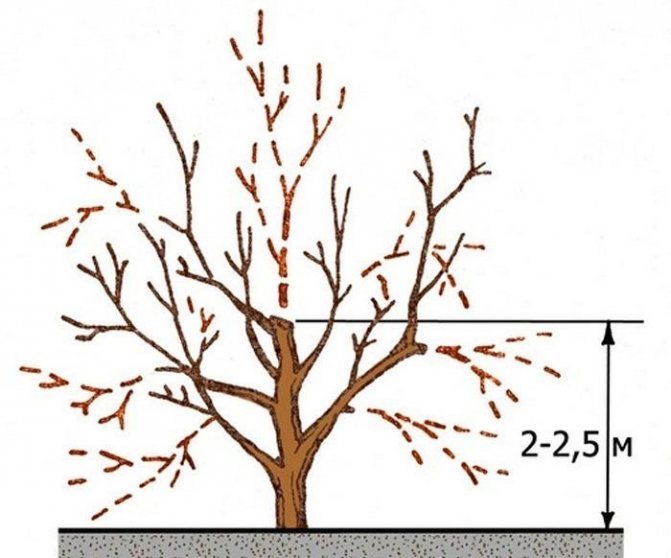

Rejuvenating pruning is often called shock pruning for a reason
Required tool
To perform pruning of cherries, the most common tools are used:
- sharp pruning shears (for thin shoots);
- lopper and hacksaw (for thicker branches);
- a sharp garden knife (for smoothing cuts on thick branches).
All instruments must be disinfected: they can be ignited in a flame or treated with a 5% solution of copper sulfate. Of course, a stepladder is needed to service mature tall trees. To cover up wounds, garden varnish or paint on natural linseed oil is used.
During the fruiting period of the tree
Hygienic or sanitary
Plants, like humans, tend to age. Its signs:
- a decrease in the number of fruits and the size of berries;
- deterioration in the taste of berries;
- frequent plant diseases.
All these manifestations of aging say about the need for anti-aging pruning.
It consists in a significant, up to the length of a two-year-old plant, shortening of all branches and is carried out after fruiting.
Radical pruning of cherries - why and why:
In order to limit growth upward
What to do, if for some reason, the cherry is strongly stretched uptaking the fruit out of human reach?
Even in this case, the height and shape of the tree can be corrected by forming a so-called leaderless or bowl-shaped crown.
We begin to correct the crown with the removal of all strongly raised and growing branches directly at the crown. This activates the development of external ramifications.
The grown branches will be located at a large angle of departure from the skeletal shoots and weaker than the previous ones. But this is exactly what we need.
After removing branches growing upward the crown will become lighter, wider and lower. As soon as the cherry recovers from the cuts, its active growth will begin. Only slight bends will remain at the site of the removed shoots.
Important in the future avoid general thickening of the crown, in time tracking the growth of shoots directed inward.
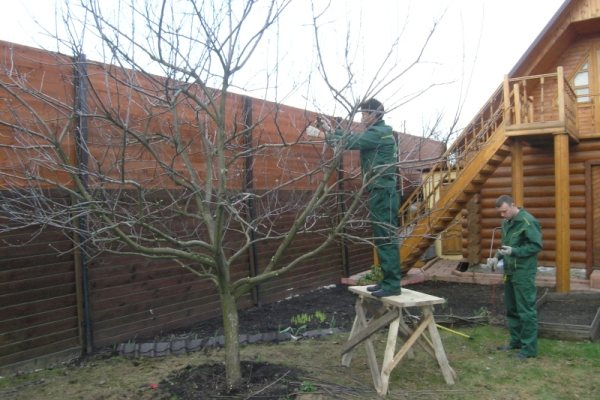

If the cherry is strongly stretched upward, you need to correct the weight and shape of the tree.
Supportive
After performing formative pruning on the tree shoots replacing the conductor will appear... It's unavoidable. They are subject to unconditional deletion.
The sooner you notice such an escape, the easier it will be to remove it and the more painless the cherry will tolerate this procedure.
You will be interested in these publications:
- How to plant cherries in the fall.
- Top of the best varieties of cherries for the Moscow region.
- Correct planting and caring for columnar cherries.
Side branches will also give growth, which are removed after fruiting. They are cut from bottom to top in decreasing order, forming tiers and giving the crown a pyramidal shape.
Otherwise, the upper shoots will darken the lower ones, leading to their weakening.
First seasonal pruning - spring
In the spring, sanitary pruning is first carried out (regardless of the age of the tree, broken, dried and diseased shoots are removed).
Anti-aging and shock treatments for old trees
Then, for old trees, rejuvenating pruning is performed (it is required about once every 5 years). Such pruning is carried out in the case of a clear decrease in the yield of the tree. A third is cut from shoots over five years old. The next year, the procedure is repeated, removing another third of the old shoots. If you have to cut a lot of skeletal branches at one time, such pruning becomes a shock for the tree. When this is indispensable, they try to greatly shorten the shoots on the skeletal branches left.
Crown formation in young cherries
In the case of young trees, after sanitary pruning, they switch to formative. It is important to know that mainly cherries fruiting occurs on horizontal branches, therefore, in addition to pruning itself, they also practice bending the branches while holding them with spacers or with the help of ropes tied to stakes.
The very first spring pruning is formative, and it is carried out already at planting (or, if cherries were planted in autumn, then next spring).
Video: work with the crown of a fruiting cherry 8-year-old
Types of crown that can be formed in cherries
There are about a dozen schemes for the formation of cherry trees, the most popular are the following:
- sparse-tiered - the easiest to form a crown, when the branches of the first order are arranged in 2-3 tiers, and each of them consists of 3-4 branches;
- bowl-shaped - 5–6 skeletal branches are located almost at the same level, evenly around the circumference;
- bushy - the undersized crown is formed in the form of a bush, which is easy to care for and from which it is easy to harvest.
Video: shaping cherries
Sparse tiered crown
On a two-year-old seedling, no more than half a meter should be left from the side branches, and the guide should rise above them by at least 15–20 cm. If you find branches extending from the stem at very sharp angles (less than 45 °), it is better to remove them immediately. When planting a one-year-old, most often there are no branches at all, so these operations are carried out after a year. Then, for several years in a row, they continue to form the crown.
When forming a sparse-tiered crown, it has to be done according to the principle “one tier per year”. It is desirable that there is about 80 cm between the tiers, and the branches within the tier are evenly distributed around the circumference. On each subsequent tier, one branch is left less than on the previous one, and they are made shorter. This type is a "classic" of gardening. It is used for tall varieties with a relatively sparse crown.
How to form a longline crown over the years, starting with planting a one-year seedling
The following procedures are followed.
- When planting, a one-year-old tree is shortened to a height of 1 m.
- After a year, if the guide has grown a lot, the total height of the tree is once again reduced to a meter height.3-4 branches of the first order are chosen so that they are evenly spaced around the circumference, and shorten them, equalizing in length. The remaining branches are cut in half.
- A year later, the second tier is similarly laid at a height of 50–80 cm from the first, leaving 2-3 branches in it. Of the branches of the second order that have grown in the first tier, no more than three vertical branches are left on each branch. They should be located in different parts of the shoot. The remaining branches are cut.
- The next year, the same procedures will be repeated, laying the third tier and forming vertical branches on the second. Each time, the branches of the next tier are made slightly shorter than the previous one. The conductor is shortened, retreating 70 cm from the upper tier.
If the work is done correctly, the height of the tree will not exceed 4 meters.
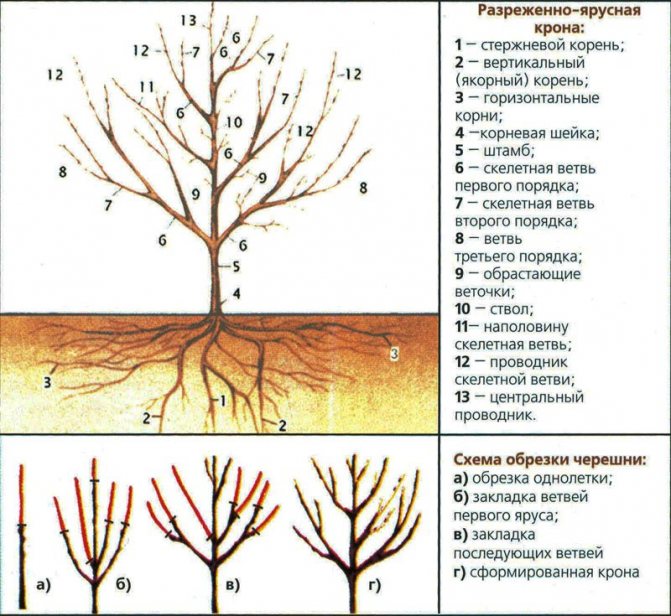

A classic tree is formed by 3-4 years
Cup-shaped crown
The formation of a crown in the form of a bowl is performed as follows:
- Immediately after planting a one-year-old seedling, pinch the shoot at a height of 50-60 cm.
- The next year, as branches of the first order appear, 5–6 pieces are left, located evenly around the circumference and almost at the same height.
- When these branches grow up to 30–40 cm, they are bent almost horizontally and tied to stakes.
- With the appearance of branches of the second order, those that grow inside the bowl are cut out.


The bowl-shaped crown is well lit by the sun
Bushy crown for low-growing varieties (molding begins in two-year-old seedlings)
Bush-shaped cherry is formed in the case of undersized varieties. 10-12 skeletal branches are created on a short trunk, as a result of which the tree resembles a sphere.
- A year after planting, 3-4 branches are selected, located symmetrically around the circumference. They are shortened to a length of 40 cm. The conductor is cut to the top of these branches. From the rest, lower located, branches (if any) leave no more than 25 cm.
- The next year, last year's shoots are greatly shortened, leaving about 15 cm.
- In the third year, 7–10 more skeletal branches are added, choosing them from those newly appeared on the trunk. They are shortened to 60–70 cm, the rest are cut out. All branches growing vertically upwards are also removed.
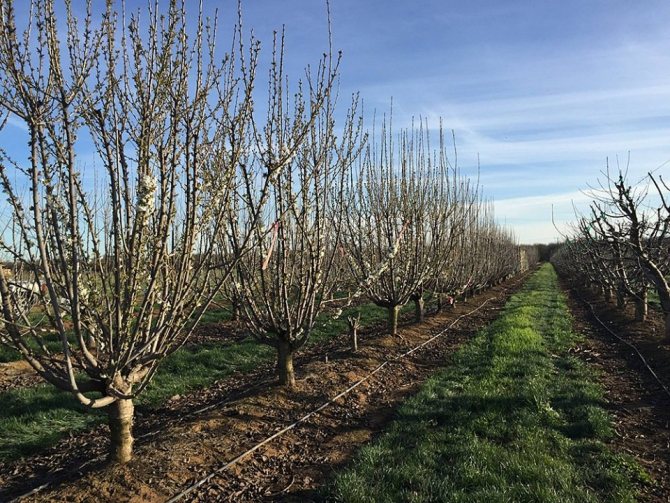

In fact, a bush cherry is not a bush at all.
Pruning bush cherries in the fall
Unlike tree cherry, in which most of the flower buds are located on bouquet branches, bush cherries form buds on annual growths. In other words, the type of fruiting of these plants is different. Shrub cherry needs more careful thinning of the crown, because over the summer, it grows heavily. It is necessary to remove dry and diseased branches, overgrowth shoots, as well as branches before the first significant branching. You should not cut off all unnecessary at once, divide the work into several seasons.
Here are some rules that will allow you to properly carry out the autumn pruning of bush cherries:
- do not cut off shoots less than 50 cm in length so that the plant does not lose strength;
- form branches not inside the crown, but outward, this will avoid thickening;
- do not touch young shoots, otherwise next year you may not wait for the harvest.
Second pruning - summer green operations before and after harvest
Not all gardeners are involved in summer pruning. In order not to be afraid of severely injuring the tree, you can use the pinching method for green shoots. This means that young shoots are simply pinched with fingers. This is done with branches that clearly thicken the crown, and growing vertically upward. This stops the growth of the shoot and stimulates its branching.
After the end of fruiting, "green" operations are repeated: remove young shoots growing in an unnecessary direction, strongly thickening the crown, shorten the shoots of this year by a third.
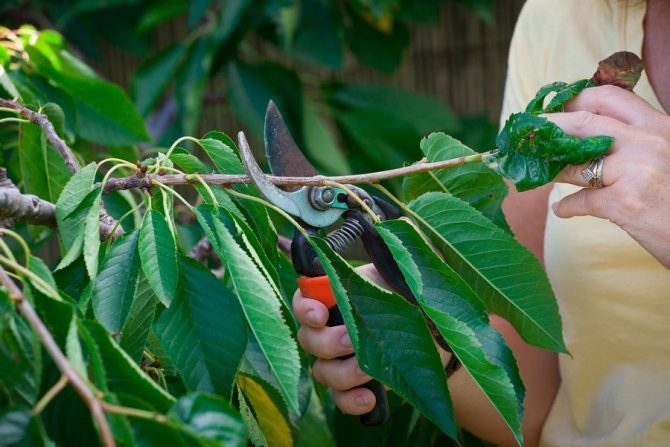

If the shoots have already begun to grow stiff, use a pruner.
Crown formation rules and methods
A correctly formed cherry crown is a spreading tree with numerous lateral shoots.Improper growth can be noticed in the first years of the plant's life. If the shoots grow at an acute angle to the main trunk, then such branches should be cut off. It is in the narrow places of the joint that moisture will accumulate and stagnate, which contributes to the spread of diseases of fungal origin. Closely located shoots attract insect pests (aphids, weevils, cherry fly).
To get a beautiful and productive cherry tree, you should plan the pruning stages in advance. In no case should you cut off the shoots chaotically. It is better to sketch out a plan for the growth of branches, and control the formation of the crown. Incorrect pruning can delay fruiting by 2-3 years.
Advice. Several methods of pruning fruit trees have become established in horticulture. They are also suitable for caring for cherries.
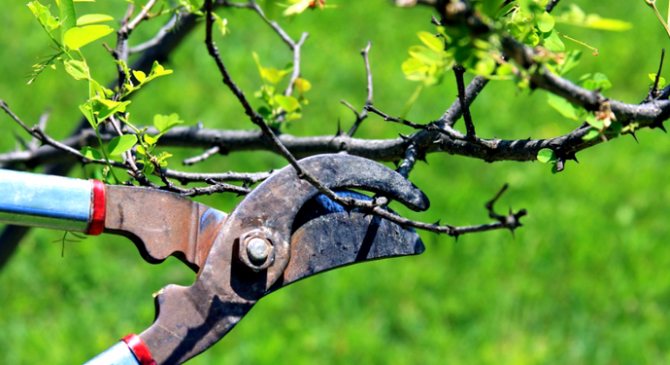

Common mistakes in cherry pruning
Possible mistakes when pruning cherries include the following:
- leaving hemp on the branches;
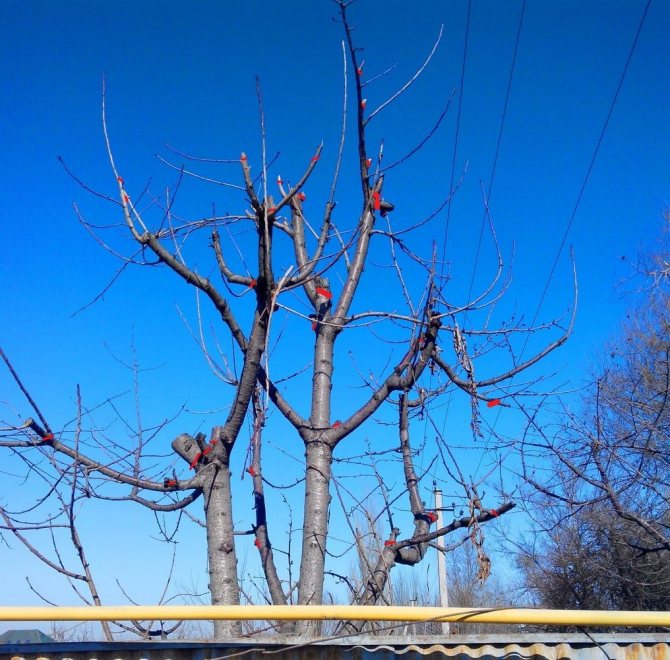

Leftover stumps lead to long wound healing
- non-compliance with the terms of work;
- transfer of shoot growth to a branch that is too weak;
- too much shortening;
- non-subordination of tiers: stronger branches on the upper "floors";
- too rough a cut, not aligned with a knife;
- poorly smeared cuts.
Why you need to prune cherry trees
Many summer residents believe that it is better not to practice pruning stone fruit trees, especially cherries and cherries, allowing the trees to grow naturally.
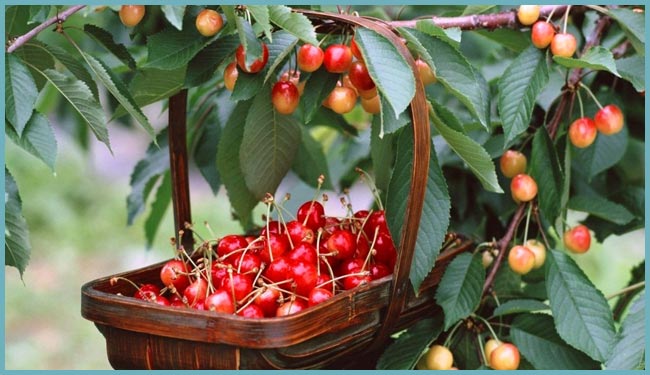

Cherry trees are pruned to increase yields
Agreeing with this is not entirely correct. Formative pruning of stone fruits allows you to improve the crown of trees (dried branches and branches are cut out, which serve as additional gates for harmful infections and pests to enter the wood). Removing the branches growing inside the crown during pruning opens up air access, this operation can significantly reduce the risk of developing pathological fungal infections.
When pruning, a strong skeleton of the tree is formed, the height of the trunk is reduced, which makes it easier to harvest, and simplifies the work of treating the garden from pests.
Advice! A strong, healthy tree is the key to a bountiful harvest, regular pruning helps to stimulate fruiting.
Rules for caring for a tree after pruning operations
Cherry reacts painlessly to pruning if it is done on time and correctly. But any wounds should be covered with garden varnish, and it is advisable to wipe them with a 5% solution of copper sulfate or 3% Bordeaux liquid before this procedure. Cut branches are burned as quickly as possible: they can contain foci of diseases and pest eggs.
There are no special measures for tree care after the usual pruning, but if you had to remove a fair amount of wood, the cherries should be well watered and fed: in the spring with an emphasis on nitrogen, in the fall - on phosphorus and potassium. In relatively cold regions, trees that are heavily cut in autumn must be insulated: the trunk circle is mulched and the trunks and bases of skeletal branches are tied with burlap.
Tips for beginner gardeners
For gardeners who first decided to tackle the pruner, it will be useful to study the theoretical part of the issue. The first pruning is best done with or under the guidance of a mentor. It must be remembered that incorrect pruning can simply kill the tree.
What tools are needed for pruning cherries
High-quality garden tools are the key to the health of the tree. When pruning, you need to remember that any damage, and even more so a saw cut or cut, is an open wound through which an infection or fungus can get. The tool must be sharp to minimize the likelihood of unnecessary damage.
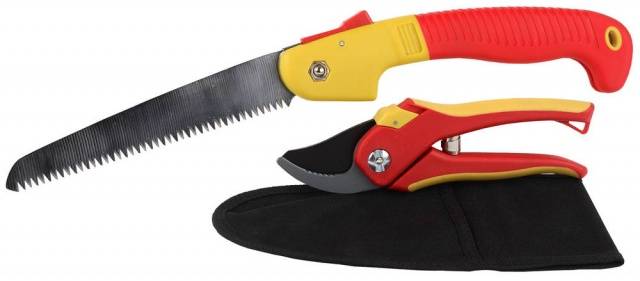

To carry out pruning in spring and summer, the gardener usually needs:
- Garden shears for removing green shoots.
- Pruner.
- Lopper.
- Garden saw.
- Garden knife.
- Stepladder (for high sections of the crown).
Before the trimming procedure, all instruments must be disinfected with a solution of copper sulfate.
How to prune branches correctly
The branches should be pruned so as to inflict as few wounds on the tree as possible. For example, when removing a branch coming from the trunk, you need to try not to touch the pocket from the bark at the bottom of the branch attachment, as well as the scar from the bark, which is on top. Such a saw cut will drag on very quickly. If you make a saw cut close to the trunk, the wound will be very large, if you retreat far, you will get a large knot.
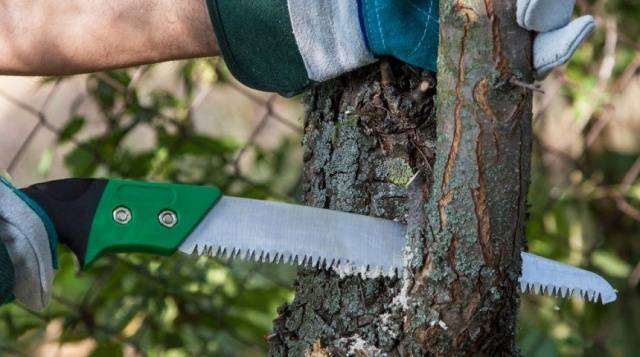

It is better to first file large branches from below, otherwise they, breaking from their own weight during filing, can tear off a piece of living bark. On the branches, the cut must be made from the bottom. When using pruning shears, cut slightly obliquely, just above the kidney.
What weather is cherry pruning carried out
Pruning is not carried out at negative temperatures, since the wood at this time is rather fragile. It is also undesirable to prune in damp cold weather, as this promotes gum flow.
Processing slices after trimming
Cuts and cuts remaining after the pruning procedure must be disinfected with a solution of copper sulfate and covered with garden varnish. This is especially true for large sections. Increased attention should be paid to treating wounds if pruning was carried out for sanitary purposes, for example, wood affected by fungus was removed.
The cuts can also be treated with ordinary natural-based oil paint. It is better to use natural garden pitch, based on fir resin, and not oil products.

